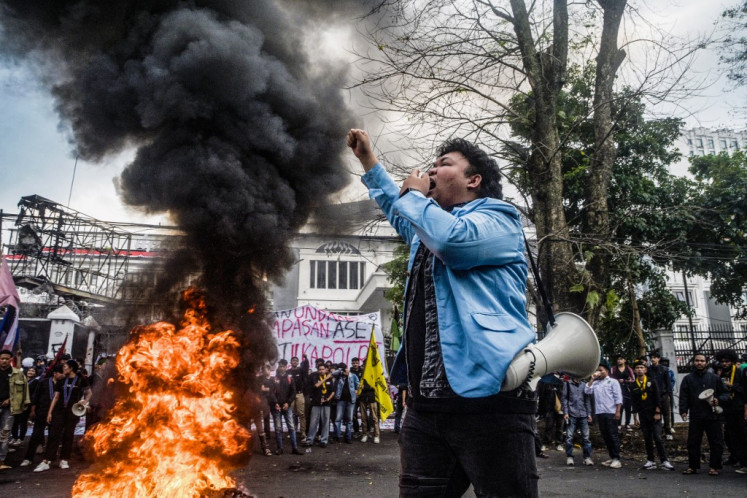Popular Reads
Top Results
Can't find what you're looking for?
View all search resultsPopular Reads
Top Results
Can't find what you're looking for?
View all search resultsIndonesian ghosts and their influence on how society behaves
Urban legend: The legendary ghost story Si Manis Jembatan Ancol has made its ways into several movie and serial adaptations and the latest one was in 2019
Change text size
Gift Premium Articles
to Anyone
U
rban legend: The legendary ghost story Si Manis Jembatan Ancol has made its ways into several movie and serial adaptations and the latest one was in 2019. (Courtesy of IMDb)
The pathway toward the entrance of Jeruk Purut Cemetery in Jakarta always gives an eerie vibe that can make anyone’s heart rate pick up.
“Now remember, you must shower once you’re home, so the spirits [from the cemetery] won’t follow you into your dreams,” Calvin, a guide at the cemetery, told The Jakarta Post during a recent visit.
Jeruk Purut is probably Jakarta’s most renowned “haunted” cemetery. For years, people have been going there to catch a glimpse of hantu Jeruk Purut (the ghost of Jeruk Purut).
Urban legends describe the ghost in the form of a headless pastor and his black dog, who wander the grounds at night.
During the day, the lush greenery of this sprawling cemetery is a welcome reprieve from the bustle of Jakarta’s concrete jungle. Groundskeepers mow the lawns as stray cats bask in the sun among the graves. An older man crouches down, laying flowers at the tombstone of a loved one. This seems like any ordinary cemetery at first glance — but the stories beg to differ.
According to locals, there are varying tales of the headless pastor.
One version tells of how the pastor abused many young women and, upon being discovered, was tortured and beheaded by the community. Another simply believes he lost his head in a tragic accident. Whatever the case, his spirit is said to remain in the cemetery to this day, along with other wayward souls.
In 2006, the story of the headless pastor ghost was made into an Indonesian horror film and, since then, people have come from far and wide to see the ghost for themselves.
“It’s only a test of courage,” said Herry Hermawan, the administrator of Jeruk Purut Cemetery. He believes the story of the pastor is a myth that has been embellished over the years.
“We believe in the mystic arts and we have always believed in spirits,” he said.
As Herry said, supernatural tales in Indonesian folklore have been around for centuries, passed down through the generations.
Perhaps this stems from Islamic influence, with both the Quran and hadith drawing reference to supernatural beings, known in Arabic as jinn.
A survey conducted by the Pew Research Center in 2012 found that 53 percent of Indonesian Muslims believe in jinn — while in neighboring Malaysia that number reached 77.
Whatever the origins, there is no doubt that in the region of Southeast Asia, belief in the spirit world is deeply ingrained in society.
Back in Jeruk Purut, Yanto Tpu, the cemetery’s assistant administrator, has experienced various strange happenings. Tiptoeing through the overgrown graves, Yanto pointed out sacred sites where inexplicable things have happened over the years. A scrawny, twisting tree catches his eye — a tree that apparently no one can remove.
Rest in peace: The solemn and quiet Jeruk Purut Cemetery is well-known as one of the most haunted spots in Jakarta. (JP/Gabriella Payne)“A man tried to cut it down,” said Yanto.
“But he was thrown back and possessed by a spirit.”
According to his story, the man died soon after from a high fever and, since then, no one has dared touch the tree. Similarly goes the story of the old, forgotten ambulance, tucked away in a dreary corner of the cemetery.
“It’s been here since the 70s,” Yanto said, the hinges of the ambulance eerily screeching as he opened the back door.
The ambulance was used to transport bodies to the cemetery for burial many years ago. The rusting vehicle had not been used for some time, so a man tried to move it — but to no avail. He soon caught a fever and, like the previous story, died soon after. Now locals believe it is haunted by different spirits.
“No one can dispose of it,” Yanto said.
“They are afraid.”
While the ghost of Jeruk Purut centers on a male, most Indonesian ghost stories are actually based on female spirits.
The harrowing tales of kuntilanak (a female ghost with long black hair), sundel bolong (a female ghost with a large hole on her torso) and Si Manis Jembatan Ancol (The Pretty Girl of Ancol Bridge) for example, haunt the minds of people throughout the archipelago. These stories share a common theme; most of these women were victims.
Whether it was a violent death, sexual assault or access to poor health care, the women from these stories all suffered in dire circumstances and came back vengeful in spirit form.
The kuntilanak, one of Indonesia’s most notorious ghosts, is said to have died during childbirth. Being unable to understand and accept its own death, the spirit remains lingering between this world and the next.
Similarly, sundel bolong (who is rumored to have been a prostitute) was a victim of rape who fell pregnant and died during childbirth. Her ghost is said to be hauntingly beautiful, wearing a pale white dress with her long, black hair cascading down — hiding a gaping hole in her back.
Legend has it she preys on young men, seducing them in the dead of night, seeking her revenge.
The ghost stories all have hidden symbolism.
Take Si Manis Jembatan Ancol, for example.
Si Manis is said to have been a young, beautiful woman who was raped and murdered by a gang of men after running away from her husband to be. Despite dying this horrible, violent death, Si Manis is the one who is punished in the story.
She is a victim, but because she abandoned her marriage she remains stuck between worlds, doomed to haunt Ancol Bridge for eternity. Although a legend, this story and that of sundel bolong strike an eerie resemblance to current-day Indonesia.
Stay away: A hearse in Jeruk Purut Cemetery has been in the same spot since the 1970s. Locals believe the hearse is haunted and that anyone who tries to move it will die. (JP/Gabriella Payne)According to a 2019 study by Singapore-based research company ValueChampion, Indonesia is the second-most dangerous country for women in the Asia-Pacific region. The study found that “subpar access to health care, lax laws regarding women’s safety and overall gender inequality” were contributing factors to the country’s poor ranking.
An Indonesian government survey from 2016 also found that around 33 percent of women aged between 15 and 64 had experienced some form of violence in their lifetime — and that is just cases that were reported.
The haunting legends of kuntilanak, sundel bolong and Si Manis Jembatan Ancol have painted these women as villains, when really they are the true victims. There is no doubt that long-standing patriarchal attitudes have influenced Indonesia’s ghost stories throughout the years — but despite all the harrowing tales, there are good spirits out there as well.
According to Heddy Shri Ahimsa-Putra, professor of anthropology at Gadjah Mada University in Yogyakarta, many ghosts are misinterpreted by people who are afraid.
“They just want to contact us,” said Heddy.
“But we are frightened. Since we don’t see them, we are afraid, but they are not necessarily bad.”
While some spirits return with dark agendas like the story of sundel bolong, Heddy said others had allegedly warned people of impending tragedy.
“There are some stories of people getting a warning when Mount Merapi will erupt or when earthquakes are about to happen,” he said.
Although the story of hantu Jeruk Purut has haunted many people, there is an undeniable note of solidarity at its core. When the community learned of the violent crimes the pastor had committed, they came together to pass judgement and punish him for his actions.
Like other ghost stories, he died a violent death, but unlike the kuntilanak and others, he was the perpetrator — not the victim. In this tale, the pastor is the one doomed to roam the cemetery in the afterlife, which ultimately serves as a warning for other potential abusers.
While there are many stories where women are the ones punished and blamed throughout Indonesian folklore, this tale sparks hope, flipping the narrative and persecuting the villain, not the victim.
Legendary tales of the spirit world have been an integral part of Indonesian culture for centuries and surely will not be vanishing anytime soon.
Ghost stories will continue to be passed on through the generations but the truly frightening tales are of modern day gender inequality and the alarming dangers faced by women in the country.
— Gabriella Payne traveled to Indonesia under a program with ACICIS Study Indonesia.

![Urban legend: The legendary ghost story Si Manis Jembatan Ancol has made its ways into several movie and serial adaptations and the latest one was in 2019. (Courtesy of IMDb)" width="698" height="999" border="0">Urban legend: The legendary ghost story Si Manis Jembatan Ancol has made its ways into several movie and serial adaptations and the latest one was in 2019. (Courtesy of IMDb)</p><p>The pathway toward the entrance of Jeruk Purut Cemetery in Jakarta always gives an eerie vibe that can make anyone’s heart rate pick up.</p><p>“Now remember, you must shower once you’re home, so the spirits [from the cemetery] won’t follow you into your dreams,” Calvin, a guide at the cemetery, told <em>The Jakarta Post</em> during a recent visit.</p><p>Jeruk Purut is probably Jakarta’s most renowned “haunted” cemetery. For years, people have been going there to catch a glimpse of <em>hantu</em> Jeruk Purut (the ghost of Jeruk Purut).</p><p>Urban legends describe the ghost in the form of a headless pastor and his black dog, who wander the grounds at night.</p><p>During the day, the lush greenery of this sprawling cemetery is a welcome reprieve from the bustle of Jakarta’s concrete jungle. Groundskeepers mow the lawns as stray cats bask in the sun among the graves. An older man crouches down, laying flowers at the tombstone of a loved one. This seems like any ordinary cemetery at first glance — but the stories beg to differ.</p><p>According to locals, there are varying tales of the headless pastor.</p><p>One version tells of how the pastor abused many young women and, upon being discovered, was tortured and beheaded by the community. Another simply believes he lost his head in a tragic accident. Whatever the case, his spirit is said to remain in the cemetery to this day, along with other wayward souls.</p><p>In 2006, the story of the headless pastor ghost was made into an Indonesian horror film and, since then, people have come from far and wide to see the ghost for themselves.</p><p>“It’s only a test of courage,” said Herry Hermawan, the administrator of Jeruk Purut Cemetery. He believes the story of the pastor is a myth that has been embellished over the years.</p><p>“We believe in the mystic arts and we have always believed in spirits,” he said.</p><p>As Herry said, supernatural tales in Indonesian folklore have been around for centuries, passed down through the generations.</p><p>Perhaps this stems from Islamic influence, with both the Quran and hadith drawing reference to supernatural beings, known in Arabic as jinn.</p><p>A survey conducted by the Pew Research Center in 2012 found that 53 percent of Indonesian Muslims believe in jinn — while in neighboring Malaysia that number reached 77.</p><p>Whatever the origins, there is no doubt that in the region of Southeast Asia, belief in the spirit world is deeply ingrained in society.</p><p>Back in Jeruk Purut, Yanto Tpu, the cemetery’s assistant administrator, has experienced various strange happenings. Tiptoeing through the overgrown graves, Yanto pointed out sacred sites where inexplicable things have happened over the years. A scrawny, twisting tree catches his eye — a tree that apparently no one can remove.</p><p><img src="http://202.158.21.182/files/images2/p15-B_1.img_assist_custom-780x588.jpg" alt="Rest in peace: The solemn and quiet Jeruk Purut Cemetery is well-known as one of the most haunted spots in Jakarta. (JP/Gabriella Payne)" title="Rest in peace: The solemn and quiet Jeruk Purut Cemetery is well-known as one of the most haunted spots in Jakarta. (JP/Gabriella Payne)](https://www.thejakartapost.com/files/images2/p15-A_1.img_assist_custom-698x1000.jpg)










